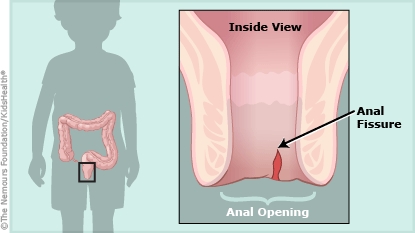Anal Fissure: How to Care for Your Child
An anal fissure is a small cut or tear in the lining of the anus (the hole where poop comes out of the body).
Most anal fissures are caused by constipation (having infrequent, hard poops) and heal by keeping the poop soft and the area clean. Less often, an anal fissure happens after a child has diarrhea. The anal fissure usually goes away after the diarrhea stops.


For all kids with an anal fissure:
-
Use petroleum jelly (Vaseline® or a store brand) or the prescribed ointment as recommended.
-
Give any medicines as recommended.
-
If your child is not toilet-trained, change diapers often and clean the area gently with a fragrance-free wipe or washcloth wet with plain water.
-
Let your child sit in a tub of plain warm water (without soap or bubble bath) for 10–20 minutes once or twice a day to ease pain and keep the area clean. Never leave a young child or baby alone in the bath.
For an anal fissure from diarrhea:
Make any diet changes as recommended by your health care provider.
For an anal fissure from constipation:
-
Increase the fiber in your child's diet:
-
For babies over 4 months old who have started solid foods, give pureed fruits and vegetables.
-
For older kids, give whole grains, beans, fruits, and vegetables. Your health care provider might also recommend fiber pills or drinks.
-
Make sure your child gets enough liquids:
-
For babies under 1 year, breastfeed or give formula as usual. Don't give extra water unless your health care provider tells you to.
-
In general, babies don't need juice. But if your health care provider recommends it, give 2–4 ounces of 100% apple, pear, or prune juice a day while the anal fissure heals.
-
Offer older kids water with meals and encourage them to drink water between meals too. Having a fun water bottle that they carry with them can help kids drink enough water.
-
Make sure your child gets plenty of physical activity.

Your child:
-
has hard poops
-
is straining when having a bowel movement (pooping)
-
has more bleeding from the anal fissure
-
is holding in their poop
-
still has the anal fissure after about 2 weeks or the anal fissure goes away then comes back

What are the symptoms of an anal fissure? It can cause pain or itching in the area (especially during and after having a bowel movement), and blood on the poop, baby wipes, or toilet paper.
Can anal fissures be prevented? It helps to: